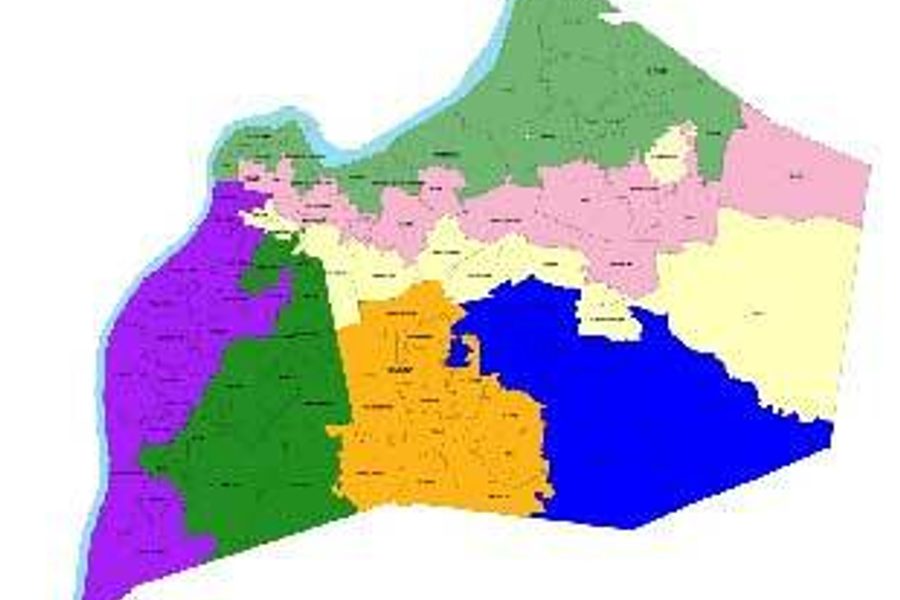Where the Seats Are
The upcoming election guarantees gains for the Democrats. They won’t be coming from the South.
Thomas F. Schaller

Poised to assume their respective posts atop new congressional Democratic majorities, Rep. Nancy Pelosi (D-Calif.) and Sen. Harry Reid (D-Nev.) can be forgiven a certain giddiness as the 2006 midterm elections approach. Pelosi recently told Time that establishment Democrats in Washington “can’t even believe the fact that I’m going to become Speaker, but they’re getting used to it.” A bit more cautious but no less hopeful, Reid has noted that “history’s on [the] side” of the minority party in a president’s second midterm cycle.
To become the first female House Speaker, Pelosi will need to gain 15 seats. For Reid to become Senate majority leader, Democrats must net six new senators. A year ago, talk of an electoral upheaval of this sort was limited to the perfunctory cheerleading of Rep. Rahm Emanuel (D-Ill.) and Sen. Chuck Schumer (D-N.Y.), the men tasked with recruiting, training and electing Democrats to Congress.
Since then, however, the conventional wisdom has reversed. Most of the “political capital” President Bush claimed to have earned in his 2004 re-election was poured down the Iraqi money pit or squandered in a failed attempt to privatize Social Security. By August 2005, whatever political currency the Administration had left Hurricane Katrina promptly swept over the broken levees.
The pre-election consensus among political handicappers like Charlie Cook, Thomas Mann and Stu Rothenberg is that Democrats will flip the House, and have a decent shot of deadlocking the Senate and an outside chance of capturing it outright. To maintain control, even if narrowly, top Republicans are relying on district-by-district, state-by-state efforts as a local buffer against pervasive anti-Bush and anti-Republican sentiments nationally.
Whatever the magnitude of the coming changes, two things are certain: The Democrats are going to gain seats in the 2006 midterms, and those gains will come from outside the South.
Regionalized partisanship rises
The 1920 elections were a Democratic disaster. Dissatisfaction with Woodrow Wilson created an electoral avalanche that would be nearly impossible in today’s era of highly gerrymandered districts and overwhelming incumbent advantages. Republicans picked up 10 new senators and 62 representatives, giving the GOP 61 of 98 Senate seats and a whopping House majority with 302 seats. The resulting 67th Congress mirrored the regional alignment of the two parties, with no Republican senators and just a handful of House members coming from the 11 states of the former Confederacy. Despite their chokehold on the South, the Democrats were a regionally confined party that found little support elsewhere in the country.
It was an era in American politics when presidential and congressional results aligned regionally in ways that have been decidedly misaligned since the collapse of the New Deal in the late ’60s.
But regionalized partisanship is beginning to emerge anew. Republicans won every southern state in the past two presidential elections and now have 18 of the region’s 22 senators and two-thirds of its House seats. In 2004, despite Bush’s two-and-a-half-point defeat of John Kerry, outside the South the Democrats actually gained congressional seats in both chambers. That’s right: If the five House seats produced by the re-redistricting of Texas orchestrated by former majority leader Tom DeLay and the five Senate pickups made possible by those southern Democratic retirements are held aside, the Democrats won the 2004 congressional elections.
Four-D Democrats
Today, the Democrats cannot swing enough seats in the near or medium term to invert the electoral maps of the late 19th and early 20th centuries – that is, to confine Republicans solely to their new, southern dominion. Nor would they want to: Democrats will never be shut out of the South the way Republicans once were because there will always be a certain number of districts in the South where African Americans and Hispanics make up the majority. What Democrats can do, however, is accelerate the regional transformation already underway in the quadrant of the northeastern and midwestern states formed by connecting Dover, New Hampshire, and Dover, Delaware, to the east, with Des Moines, Iowa, and Duluth, Minnesota, to the west.
Call it the “Four-D Rectangle.”
The Cook Political Report publishes a partisan index that measures the House district-level performance of presidential candidates. Rising partisanship has shrunk the number of split districts, that is, districts that vote for Democratic presidential candidates but have a Republican member of Congress, or vice versa. Republicans currently represent 59 districts that either tilt Democratic or which Bush won by narrow margins, and 44 of these seats are located in the Four-D Rectangle.
Consider Connecticut. Although the Nutmeg State has already drawn plenty of attention for its bloody, intra-party squabble between Ned Lamont and Joe Lieberman in the Senate race, it is Connecticut’s House steats that are more indicative of the electoral situation. This blue presidential state has only five House seats, three of which are represented by the sort of moderate, “Rockefeller Republicans” who once formed the backbone of the GOP: Nancy Johnson, Chris Shays and Rob Simmons.
None of the three received at least 60 percent of the vote in 2004, and both Shays and Simmons are prime Democratic targets because they won with less than 55 percent. Defying the White House and his fellow Republicans, the embattled Shays made national headlines by calling for a timeline to withdraw American troops from Iraq. His defection was quickly deemed the Shays Rebellion.
Along with Connecticut, the Emanuel-led Democrats are also eyeing winnable seats in Illinois, Indiana, Iowa, Michigan, Minnesota, New Hampshire, New York, Ohio and Pennsylvania. Democratic challengers are even causing Republicans headaches in places like Idaho, eastern Washington, and Wyoming’s at-large seat. By contrast, about half of the small group of Democratic incumbents in jeopardy of losing despite a general tailwind this cycle are southerners: Louisiana’s Charlie Melancon, South Carolina’s John Spratt and two Georgia Democrats.
Schumer-freude
The Northeast and Midwest are also home to four of the five most vulnerable Republican senators running for re-election this cycle: Missouri’s Jim Talent, Ohio’s Mike DeWine, Pennsylvania’s Rick Santorum and Rhode Island’s Lincoln Chafee. The fifth is Montana’s Conrad Burns.
None of the five targets are in the South, the region that produced five new Republicans in 2004 to fill the vacancies created by the simultaneous retirement of five Democratic senators. Current Rep. Harold Ford (D-Tenn.) is a formidable campaigner who hopes to take the Senate seat being vacated by Majority Leader Bill Frist, and the “macaca” blunder of Sen. George Allen (R-Va.) has breathed new life into party-switcher Jim Webb’s Virginia campaign. But these two seats are considered second-tier opportunities.
Meanwhile, the Democrats’ chances of picking up the sixth and decisive seat Schumer and Reid need for a majority are as good in the Southwest as the Southeast. In Arizona, well-financed millionaire Jim Pederson has an outside chance of upending two-term Republican incumbent Jon Kyl, who is a lackluster campaigner. And in Nevada, former President Jimmy Carter’s son Jack is closing ground against rookie Republican John Ensign.
Even if Democrats come up short, netting just three or four seats this cycle, the Senate outlook is just as promising two years hence. The Democrats are defending 18 seats to just 15 for the Republicans in 2006, but in 2008 the split is 21 Republican seats to only 12 Democrats. If Reid fails to get his majority this time around, he’ll be poised to do so next cycle.
The emergent pattern is clear: To forge a House majority, the Democrats will need to convert the purple Midwest states to blue, make the blue states of the Northeast bluer, and snag the odd seat here and there in the interior West. The Washington Post’s Dan Balz and David Broder confirm that top Republican strategists, speaking off-the-record about their party’s prospects, are predicting doom: “Republicans face potential losses in every section of the country, but the area that concerns strategists most is the arc of states running from the Northeast across the Midwest.”
Party correction
Evidence of this pattern can be found across the ballot. In January 2001, there wasn’t a single Democratic governor in any of the eight states of the interior West; there are four now, and if 2006 Democratic nominees in Colorado and Nevada win it could rise to six. The Republicans are almost certain to lose the New York and Ohio governorships, and Democrats are also favored to win in Maryland and Massachusetts. In the 2004 state legislative elections, Democrats gained enough seats outside the South to more than compensate for their southern congressional losses, flipping control of eight chambers, only one of which was in the South.
Though Pelosi and Reid would never say so publicly, national Democrats are benefiting from a regional correction to the realignment that began with the South’s Republican conversion following the Brown v. Board ruling and the civil rights movement. To accelerate this process, Democrats must expand and consolidate their control over the Northeast and Midwest by purging as many of the remaining “Rockefeller Republicans” as possible.
For many in the Democratic establishment in Washington, this is the new regional winning formula for the party. As Pelosi might say, they’d better start getting used to it.





